 |
 |
|
 |
Layoff letters, bumping notices to go to employees May 1 |
 |
 |
One hundred sixty employees from all Mn/DOT bargaining
units will receive formal notice May 1 that they could be laid off effective
June 18, according to Rich Peterson, acting director, Office of Human Resource
Operations.
An additional 232 employees will receive notice that they are "at risk"
for being bumped from their current jobs. Names of employees receiving these
notices are considered private and are protected under the state’s Data Practices
Act.
"The number of layoff notifications necessarily will exceed the number
of final layoffs," Peterson said. "The layoff list currently reflects
the worst-case scenario. As the June 10 ‘decision day’ proceeds and employees
select from their various options, it will be clearer which and how many employees
will actually separate from service with Mn/DOT."
On May 1, managers will deliver a letter to affected employees that spells
out their options and provides them with the name of a Human Resources staff
member for assistance. Employees will also receive an information packet containing
a list of important dates, a layoff "Opportunities and Responsibilities"
booklet, an insurance fact sheet, a list of layoff information sessions and
videoconference training sessions, and a list of resources available for employees
at the Arden Hills Training Center.
Employees who don’t receive a layoff letter but who are interested in volunteering
for layoff must submit their offer in writing to their district engineer or
office director by May 2. Volunteers must meet certain criteria, including that
their layoff will protect another employee from being laid off. Employees may
volunteer for layoff up to May 30, but there is no guarantee that their offer
will be considered for acceptance if made after May 2. The division directors
will review the voluntary layoff requests before approval.
"This is a difficult time for individual employees and for us as an organization,"
Peterson said. "The best way for affected employees to handle these changes
is to keep as informed as possible—through their managers, their union representatives,
as well as through the layoff Web sites that Mn/DOT and the Department of Employee
Relations are maintaining."
For more information, visit Mn/DOT’s layoff Web site (http://ihub/layoffguide/)
and DOER’s site (http://www.doer.state.mn.us/Layoff/Resources1.htm).
By Chris Joyce
Resources available to dislocated employees
-
Employee information sessions (May 5-9) at the Arden Hills Training
Center. The four-hour sessions, offered twice each day, will include information
on the layoff process (bumping, claiming, decision day, etc.), employee
benefits and insurance coverage, unemployment insurance, dislocated worker
program, workforce centers and services, Minnesota State Retirement System,
deferred compensation and the state’s Employee Assistance Program. Registration
is required. Click
here for more information.
NOTE: There will be a shuttle service between the Transportation Building
and the Arden Hills Training Center for the morning sessions only. The vans
will leave the Transportation Building each day at 7:15 a.m. and will leave
from Arden Hills at 12:45. Employees can contact Angie Rivera at 651/297-0977
to reserve a spot.
-
Videoconference sessions (May-June). Human Resources will present
a series of sessions to help employees gain resources for managing a career
transition. The sessions will be offered in videoconference rooms statewide
from noon – 1 p.m., starting May 14. Employees are invited to attend one
or all sessions and to bring their lunch. Registration is required. Click
here for more information.
- Employee Career Resource Center (May 5-June 17) at the Arden Hills
Training Center. A Career Resource Room will be available from 8 a.m. until
4 p.m. weekdays to employees who receive a layoff or "at risk" letter.
Computer work stations with high speed Internet access will be available for
employees to use for writing resumes, writing cover letters, searching for
jobs on the Internet, etc. Office of Human Resources staff will be available
to assist. Registration is required. Click
here for more information.
-
Links to more information:
Mn/DOT’s layoff Web site (http://ihub/layoffguide/)
DOER (http://www.doer.state.mn.us/Layoff/Resources1.htm)
AFSCME (http://www.afscmecouncil6.org/
MAPE (http://www.mape.org/)
MGEC (http://www.mgec.org/)
MMA (http://www.middlemanagementassn.org/)
|
back

|
 |
Workers Memorial Day observance features traveling national memorial |
 |
 |
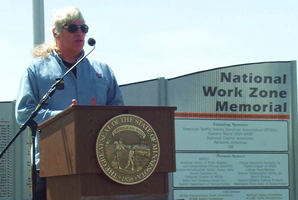 |
Brian Bruckhoff, transportation specialist, Mankato, speaks during
Workers Memorial Day in Mankato. Photo by Rebecca Arndt
|
Flanked by the National Work Zone Safety Memorial and 28 empty chairs draped
with safety vests at this year's observance of Workers Memorial Day in Mankato
April 28, speakers from the unions as well as from the Department of Public
Safety and Mn/DOT eulogized highway workers who died while working on Minnesota's
state highways.
Speakers and attendees alike mourned the loss of these individuals along with
the loss of hundreds of other workers who died while working on the nation’s
highways, represented by the names listed on the national memorial transported
to the observance.
Joining the speakers were employees from Mankato/District 7 and friends and
family members of two Mn/DOT employees who died while working on the state’s
roads.
Speaker Brian Bruckhoff, a District 7 employee who was seriously hurt in a
1990 work zone crash, urged the public to use more caution. He also called on
his fellow highway workers to support each other on the job.
"We don’t have a lot of control out there in the work zones, so we need
to stay alert and look out for each other," he said.
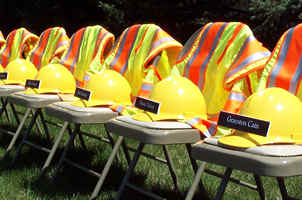 |
Twenty-eight vest-draped chairs, hard hats and name tags of Mn/DOT
people who died working on state highways create a graphic reminder
of the human cost of work zone crashes. Photo by Rebecca Arndt
|
The need for greater caution in work zones shows clearly in the number of crashes
recorded in 2002, Bruckhoff said. There were 2,784 crashes in work zones in
2002, a 22 percent increase compared with 2001. Also during 2002, 18 people
died in work zone crashes. That, he pointed out, is an increase of 80 percent
from 2001 and is the highest number of fatalities since 1990.
"We value our employees who put their lives on the line to build, maintain
and protect Minnesota’s roads," added Lt. Gov./Commissioner Carol Molnau.
"Worker Memorial Day gives us an opportunity to reflect on the contributions
of workers who died in that effort. It’s a time when we re-dedicate ourselves
to safety."
The National Work Zone Safety Memorial, which is sponsored by the American
Traffic Safety Services Association, will travel to more than a dozen cities
this year to help raise public awareness about work zone safety.
|
back

|
 |
‘FAST’ lanes proposed for reducing highway congestion |
 |
 |
New toll lanes on state freeways and highways could result from the April 24
proposal of Gov. Tim Pawlenty, U.S. Rep. Mark Kennedy, and Lt. Gov./Commissioner
Carol Molnau for reducing congestion on Minnesota roads.
The proposal, known as Freeing Alternatives for Speedier Transportation, would
add these toll lanes to busy freeways in the Twin Cities metro area. User-fee
financed lanes on major state roadways are currently used in California, Texas
and Virginia, but current law prohibits tolls on interstate highways.
Kennedy, however, has introduced a bill in Congress that would allow such lanes.
Under the terms of this proposal, private firms would build and initially finance
the FAST lanes. Revenue from tolls would eventually pay for construction.
Tolls would be collected electronically from pay cards as vehicles enter the
lanes, eliminating the need for tollbooths and collectors. Rates would rise
as congestion increases on nearby lanes.
Kennedy’s legislation would also require that toll revenue could only be used
to fund the additional lanes. Once revenues have paid for the expansion, fee
collections would end.
"We need the federal government to encourage new approaches to road construction
and adding capacity to overcrowded roadways," said Molnau. "We would
welcome this option to use this new tool on several major interstate corridors.
In the meantime, Gov. Pawlenty and I want to try this approach on major state
highways."
Pawlenty and Molnau named several interstate corridors such as I-494, I-94
and I-35W that might qualify as candidates for new FAST lanes. Mn/DOT will also
study the possible use of similar lanes on state highways such as Hwys 10, 36
and 55/52.
Kennedy said he welcomed support from Pawlenty and Molnau and that he plans
to conduct a series of public meetings to explore this approach.
"I am pleased that Gov. Pawlenty and Lt. Gov. Molnau support this critical
legislation," he said. "There is a great disparity today between highway
revenue and highway needs. This bill opens a new revenue stream, allowing us
to solve the serious congestion problems we face in an innovative way."
By Craig Wilkins
|
back

|
 |
FHWA recognizes Mn/DOT for environmental commitment |
 |
 |
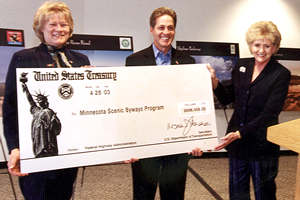 |
Lt. Gov./Commissioner Carol Molnau and Sen. Norm Coleman accepted a
check from FHWA Administrator Mary Peters for scenic byway projects
at a news conference last week. Photo by David Gonzalez
|
Lt. Gov./Commissioner Carol Molnau, joined by Sen. Norm Coleman, accepted a
check for $696,456 on behalf of the Minnesota Scenic Byway Commission at a news
conference held last week. Presented by FHWA Administrator Mary Peters, the
check is a grant for FY 2003 projects on Minnesota’s scenic byways.
"Receiving this funding means we can continue to preserve, enhance and
improve the quality of our scenic byways," Molnau said. "Our byways
offer an inviting way for travelers to explore Minnesota’s natural, cultural
and historical resources."
Since the program’s origin in 1992, Minnesota has received $8.1 million for
91 projects to develop its 20 scenic byways. The program began through a memorandum
of understanding involving Mn/DOT, the Department of Natural Resources, the
Office of Tourism and the Historical Society, all members of the Minnesota Scenic
Byway Commission.
Each year FHWA administers a total of about $25 million in discretionary grants
to state scenic byway programs nationwide. These grants enable states to develop
eligible projects along highways designated as All-American Roads, National
Scenic Byways and state-designated Scenic Byways.
Minnesota was the only place outside of Washington, D.C., this year in which
the FHWA held an event to announce the funding for scenic byways.
"This says a lot about the Minnesota program, and it also demonstrates
that we are recognized across the nation for our dedication to protecting and
preserving the environment," said Mark Anderson, scenic byway coordinator,
Office of Environmental Services.
Peters also recognized Mn/DOT as one of 12 recipients nationwide of FHWA’s
Environmental Excellence Award for environmental research and for its first-place
win in the FHWA’s Greener Roadsides 2002 Photo Opportunity in the public awareness
category.
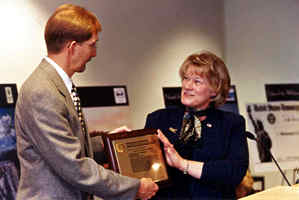 |
Lt. Gov. Molnau presented the FHWA Environmental Excellence award to
David Larson, Landscape Architecture Unit. Photo by David Gonzalez
|
Environmental excellence award
On April 22, David Larson, Sr. Landscape Architect, Office of Technical Support,
accepted the 2003 FHWA Environmental Excellence award in the environmental research
category for Mn/DOT’s Aesthetic Initiative Measurement Systems project. This
research was noted as the first of its kind across the nation.
The AIMS project consisted of developing and testing instruments and protocols
that Mn/DOT can use to understand and document how travelers perceive the attractiveness
of Minnesota highway corridors.
""We wanted to look at the visual quality and aesthetics of the corridor
from the public’s perspective and the development of this research tool allowed
us to do that," Larson said.
Sixty-three Minnesotans participated in the research project. The volunteers
split up into three groups, each traveling by van to a selected route in Duluth,
Rochester and the Twin Cities. Trained facilitators asked the volunteers to
call out any views along the way that negatively or positively attracted their
attention. At regular intervals, facilitators stopped and encouraged discussion
about each recorded view, asking the participants what made the view attractive
or unattractive.
The research showed the public’s strong preference in the following areas:
-
Good maintenance: attractive landscape, vegetation management, litter
free
-
Perception of nature: wetlands, natural settings, wildlife
-
Good design elements: planting design, railings, walls and bridge
materials
-
Good highway design within an attractive landscape context: vistas,
natural features of the surrounding landscape, such as geology, hills and
forests
"The research confirmed our thoughts on what the public likes to see,"
said Larson. "But now we can measure with confidence what our customers
want and expect. Such information up front makes it easier and ultimately more
cost-effective to determine ways to meet customer needs."
For more information concerning the AIMS project, contact Larson at 651/284-3774.
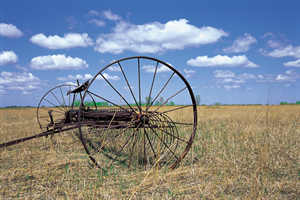 |
These wheels give a sense of history to the Pembina Trail Scientific
and Natural Area near Crookston, where early traders used oxcarts to
transport buffalo hides, furs and supplies. Photo by David Larson
|
Public awareness award
Mn/DOT also received a first place award in the public awareness category of
the FHWA 2002 Photo Opportunity Contest for its piece called "A Guide to
Minnesota’s Prairie Passage Route and Sites."
This 40-page guide displays a collection of photos and stories that captures
the essence of Minnesota’s transportation system and its history.
Prairie Passage, a national effort, promotes awareness of natural and cultural
resources. Prairie Passage partners encourage the protection and planting of
native wildflowers and grasses along roadsides.
"The guide provides travelers with a number of public sites where they
can learn about the prairie and the transportation systems that have shaped
their lives," said Kathy Bolin, project coordinator, Office of Environmental
Services.
Copies of the guide are distributed at travel information centers, convention
visitor bureaus, chambers of commerce and through many state parks, environmental
learning centers and similar locations.
"We hope this guide will help further the prairie passage efforts and
provide opportunities for communities to discover the stories in the prairie
heritage – past, present and future," Bolin said. Contact Bolin at 651/284-3765
for more information.
"I am pleased with the work that our employees have done, and I want them
to know that their work is important," said Molnau, who later presented
the award to the recipients to be placed in their offices.
"They’re the ones who dedicated their time and effort into these projects.
They deserve to hold on to these awards," she added.
For more information about the news conference and scenic byway projects, visit
http://www.fhwa.dot.gov/pressroom/fhwa0313.htm.
By Daneeka Marshall-Oquendo
|
back

|
 |
State, regional leaders explore ways to boost SW Minnesota economy |
 |
 |
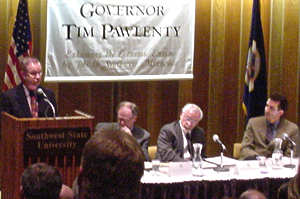 |
Dave Trooien, Willmar/District 8, engineer, speaks during the forum
held at Southwest State University in Marshall. Photo by Sandy East
|
A public forum exploring ways to bolster the economy of southwestern Minnesota
attracted Gov. Tim Pawlenty, Willmar/District 8 engineer Dave Trooien and several
other state officials to Southwest State University in Marshall on April 21.
The forum, which was entitled "Enhancing the Economic Engine for Jobs
in Southwest Minnesota," also drew 250 regional education, community and
business leaders to explore ways for promoting job creation and economic growth
in the area.
Pawlenty and Trooien led the forum with Trade and Economic Development Commissioner
Louis Jambois; David Danahar, president of Southwest State University, and John
Drown, a Schwan’s Food Co. executive in residence at the university.
Small discussion group recommendations included improving highway access between
the region and the Twin Cities; airport reviews handled by state instead of
federal agencies; more collaboration among business, agricultural and state
agencies; and improvements to the region’s highways and other transportation
infrastructure.
Trooien said Mn/DOT and District 8 support achieving greater economic vitality
in the region by working with communities via the Area Transportation Partnerships
and other cooperative efforts. He cited the 1999 Interregional Corridor Study
as promoting more efficient movement of people and goods between regional trade
centers, which strengthen the state’s economy.
Trooien also talked about an IRC study Mn/DOT completed in 2002 of Hwy 212
from the South Dakota border to I-494 in Eden Prairie. The study’s results,
Trooien said, produced a model of how communities would look along the 150-mile
route after improvements. The model received strong acceptance from affected
units of government, he said.
Another example Trooien mentioned was the rebuilding of Hwy 23 which includes
the section now under way between Willmar and New London. This, he said, is
an example of a cooperative effort to create a safer highway between Willmar
and St. Cloud that will accommodate more traffic and thus enhance the region's
mobility and economic vitality.
"Support shown by the City of Marshall for a Hwy 23 project in Paynesville,"
he said, "demonstrates the mutual interest each community along the route
has for improving the Hwy 23 corridor and for taking the needed steps to strengthen
the region’s economy and its future."
By Sandy East and Craig Wilkins
|
back

|
 |
Workshop focuses on transit emergency preparedness |
 |
 |
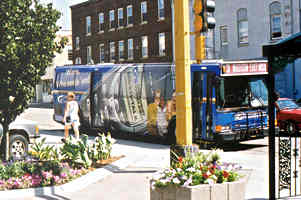 |
A Mankato Heartland Express bus stops in downtown in summer 2002. Greater
Minnesota transit systems like Mankato may be examining security measures
in the future. Staff photo
|
More than 19 security, transit and transportation professionals attended an
emergency preparedness scoping workshop on Wednesday, April 15, at the Mendota
Truck Center. The group had three goals -- to discover how local transit systems
can upgrade security and emergency preparedness, to explore ways systems can
serve their communities in an emergency and to help shape Mn/DOT's role in these
endeavors.
"It's just a matter of time before the Federal Transportation Administration
will require even the smallest transit system to have an emergency preparedness
plan in place," said Donna Allan, Office of Transit director. Allan added that
some terrorist incidents have targeted transportation systems and it makes sense
for transit systems to consider their readiness to respond to natural and manmade
incidents.
Presenters from the state's Emergency Management Division and Hennepin County
Public Works explained statewide coordinated efforts supporting emergency planning
at local levels. Program managers from Bemidji/District 2 and Willmar/District
8 shared perspectives on how local transit system providers may be the only
source of emergency service in many parts of rural Minnesota.
"We want to encourage transit systems and county emergency coordinators to
work together," said Bob Works, workshop coordinator and transit representative.
Works said that Mn/DOT will work with Greater Minnesota's 67 transit systems
to encourage them to get involved in each county's emergency preparedness plan;
advise systems about agreements required for reimbursement by the Federal Emergency
Management Administration; and generate a timeline to establish an emergency
readiness strategy that will useful to a wide range of systems.
By Sue Stein
|
back

|
 |
‘Bio-engineering’ brings low-cost solution for erosion along recreational trail |
 |
 |
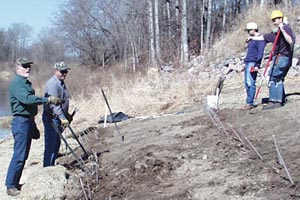 |
Staff from Mn/DOT and the DNR place bundled willow cuttings to stabilize
an eroded area of the Little Fork River near Littlefork. Photo by
Lori Belz
|
An eroded riverbank that has become popular with snowmobilers will soon benefit
from an old technique with a hot new name. Mn/DOT, the Department of Natural
Resources and other agencies will use "bio-engineering" to limit further
erosion along the Little Fork River near Littlefork in Koochiching County and
help repair flood-related damage.
Mn/DOT became involved because the erosion occurred along the railroad roadbed
between Bemidji and International Falls. This roadbed is part of Mn/DOT’s rail-banking
program, which preserves unused rail right of way for public recreational use.
Some riverbank damage resulted from ice jams that caused floods which carried
away trees and debris while knocking out an old truss-style railroad bridge.
Damage to the riverbank’s vegetation grew worse when a contractor removed the
bridge for salvage.
To prevent further erosion, Lori Belz, natural resources specialist; and Paul
Walvatne, forester, Environmental Services; Todd Campbell, Duluth/District 1
hydraulics engineer, and Tom Jacobson, landscape specialist, Duluth; joined
staff from the DNR and the county to find a solution.
The first steps took place last fall when bulldozing helped recreate the area’s
original contours. Next came seeding and placing an erosion control mat. Then,
this spring, crews from DNR and Mn/DOT placed wattles—bundled cuttings of willow—in
troughs of soil to help slow erosion from rainwater
The crew secured the wattles with live stakes of willow and dogwood branches
planted in wetlands near the river and between the wattle lines. They also planted
250 willow and dogwood seedlings to promote the growth of woody plants in the
area. Both species will grow roots quickly and stabilize the soil.
The use of the cuttings and the planted branches provides a fast, low-cost
solution to the problem, Walvatne said.
"Bio-engineering applications such as this one at Littlefork show that
we can use natural materials to solve a lot of our problems," he said.
By Craig Wilkins
|
back

|
 |
Lt. Governor implements take-home vehicle policy |
 |
 |
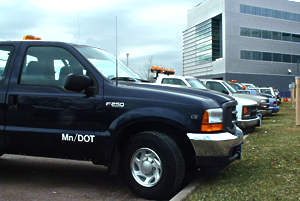 |
These fleet vehicles parked in front of Metro District’s Waters Edge
building are now part of much smaller pool available to Mn/DOT employees.
Photo by Kent Barnard
|
Employee ideas for saving costs and finding efficiencies are a force behind
change at Mn/DOT. Suggestions have ranged from better building management to
ways to generate new revenue. One of the categories that generated frequent
mentions is how the department manages its fleet, primarily in the assignment
of take-home vehicles to employees.
Comments from several employees were included in a new
take-home vehicle policy that Lt. Gov./Commissioner Carol Molnau recently
approved. They include clearly defining who is eligible to take Mn/DOT vehicles
home and applying guidelines
for vehicle use with statewide consistency.
The policy also requires that authorization of a take-home vehicle must also
have written approval from the Commissioner of Transportation or her designee.
"Transportation is our business and employees clearly need to be out on
the road to attend to work-related tasks, sometimes well into the evening hours.
The key is making sure that department vehicles are being used appropriately
and to further Mn/DOT’s key priorities and functions," Molnau said.
Mn/DOT currently has 144 vehicles assigned to employees, down from 244. Most
of the vehicles are vans and pickups used for business, including construction,
hazardous materials inspection and traffic signals and radio repair.
In addition to the take-home vehicle policy, Mn/DOT is implementing other employee
ideas. These include:
-
Using an electronic document management system to ensure documents are
archived digitally versus more expensive hard copy storage
-
Reducing unnecessary expenditures and spending on promotional items
-
Limiting travel to conferences and meetings
-
Reducing year-end spending by reallocating budget balances at the end of
a biennium to construction programs
-
Reviewing Mn/DOT's information technology practices to create greater efficiencies
-
Creating a policy that focuses on using e-mail instead of paper for document
sharing
-
Reviewing manager positions
By Jeanne Aamodt
|
back

|
 |
B-BOP focuses on bikers, walkers, transit riders during National Bike Month |
 |
 |
Dust off your bike and don your helmet. Discover a new way to get to work on
Thursday, May 15, and observe the annual Bike, Bus or Pool Day that promotes
alternatives to driving alone.
B-BOP Day represents efforts by Mn/DOT, transit agencies, private employers
and other entities to promote alternatives to single-occupied vehicles for commuting.
It's part of a month-long campaign to encourage commuters to try carpooling,
transit or biking.
State employees can join one of seven bike rides around the Twin Cities. Rides
originate from Summit Avenue, Como Avenue, West St. Paul, Battle Creek, Roseville
and the Vento and Gateway Trails. All routes end at the State Capitol grounds
at approximately 8 a.m. All bikers—state employees and others—are welcome.
Visit the Web site at http://www.b-bop.org/stpaul_bikeride.html
for more information, register on-line or contact your respective
route leader. For more information on other B-BOP activities, check out the
Web site at: http://www.b-bop.org/
May is also National Bike Month and Mn/DOT reminds bicyclists and drivers to
share the road. Bicyclists have the same rights and responsibilities as other
vehicle drivers.
To improve safety, both bicyclists and motorists should be aware of Minnesota's
bicycle laws, including the following:
-
Ride on the right with traffic and obey all traffic signs and signals
-
Legal lights and reflectors are required at night
-
Bicyclists may ride two abreast but shouldn't impede normal traffic
-
Yield to pedestrians; give an audible signal before passing
-
Motorists, when passing, must allow at least three feet between their vehicle
and a cyclist
Bicyclists are strongly encouraged to wear a helmet at all times.
By Sue Stein
|
back

|
 |
Spring issue of StateLines now online |
 |
 |
Mn/DOT’s 511 traveler information service is just one of several topics you
can read about in the latest issue of StateLines, a quarterly online
newsletter published by and for Minnesota state employees.
In the spring 2003 edition, you’ll also find a message from Gov. Tim Pawlenty
talking about the positive side of change.
"People tend to look at our budget crisis in an entirely negative light,"
he writes. "While it is certainly a challenge, it is also an opportunity.
Crisis often generates transformation. This crisis gives us an opportunity to
reform our government."
Other articles in this issue include how the National Guard played an important
role in troop deployment for the Iraq conflict; how online driver and vehicle
services are helping the Department of Public Safety reduce delays and frustration
for Minnesota motorists, and where state employees can find discounts on entertainment
and services.
StateLines also has links to regular features such as a calendar of
events, state jobs, health-related information, agency highlights and employee
profiles.
Click here to read StateLines (http://www.statelines.state.mn.us/)
now or use Mn/DOT Newsline’s side navigation bar to access StateLines
any time.
|
back

|
 |
|
 |



